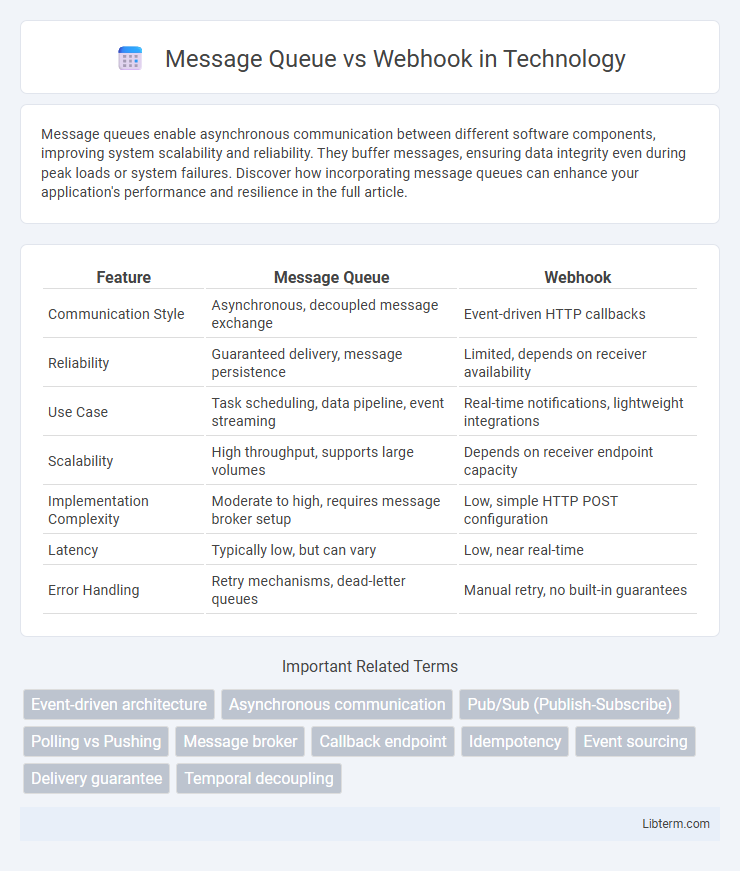Message queues enable asynchronous communication between different software components, improving system scalability and reliability. They buffer messages, ensuring data integrity even during peak loads or system failures. Discover how incorporating message queues can enhance your application's performance and resilience in the full article.
Table of Comparison
| Feature | Message Queue | Webhook |
|---|---|---|
| Communication Style | Asynchronous, decoupled message exchange | Event-driven HTTP callbacks |
| Reliability | Guaranteed delivery, message persistence | Limited, depends on receiver availability |
| Use Case | Task scheduling, data pipeline, event streaming | Real-time notifications, lightweight integrations |
| Scalability | High throughput, supports large volumes | Depends on receiver endpoint capacity |
| Implementation Complexity | Moderate to high, requires message broker setup | Low, simple HTTP POST configuration |
| Latency | Typically low, but can vary | Low, near real-time |
| Error Handling | Retry mechanisms, dead-letter queues | Manual retry, no built-in guarantees |
Introduction to Message Queues and Webhooks
Message Queues are asynchronous communication systems that store and forward messages between distributed applications, enabling reliable and scalable data exchange without requiring direct connectivity. Webhooks provide a lightweight, event-driven mechanism where a server sends real-time HTTP callbacks to a client URL when specific events occur, ensuring timely notifications with minimal overhead. Both methods facilitate inter-service communication but differ in operation: message queues emphasize guaranteed delivery and decoupling, while webhooks prioritize immediate event-triggered updates.
How Message Queues Work
Message queues operate by decoupling producers and consumers through an asynchronous communication model where messages are stored in a queue until the consumer processes them. Each message is typically delivered once, ensuring reliable message delivery even in distributed systems, with features like message persistence, retries, and ordering guarantees. This architecture supports load balancing, fault tolerance, and scalability by enabling consumers to process messages at their own pace independent of producers.
How Webhooks Operate
Webhooks operate by sending real-time HTTP POST requests to a specified URL whenever an event occurs, enabling immediate data transfer between systems without polling. Unlike message queues that store and manage messages until processed, webhooks rely on the event source to push data directly, ensuring low-latency communication. This push-based mechanism requires the receiving server to be always available to handle incoming requests promptly and securely.
Key Differences between Message Queues and Webhooks
Message Queues provide asynchronous communication by storing messages until the receiver is ready, ensuring reliable delivery and decoupling system components. Webhooks operate via real-time HTTP callbacks, pushing data instantly from one system to another without persistent storage, making them suitable for event-driven notifications. Key differences include message durability and retry mechanisms in Message Queues versus the immediate, stateless request-response nature of Webhooks.
Pros and Cons of Message Queues
Message queues provide reliable, asynchronous communication by decoupling services, ensuring message delivery even during system failures or downtime, which enhances system resilience and scalability. However, message queues can introduce added complexity in setup and maintenance, require managing message ordering and duplication, and may cause increased latency compared to direct HTTP-based webhook calls. They are ideal for high-throughput, fault-tolerant architectures but can be overkill for simple, real-time event notifications better suited to lightweight webhooks.
Pros and Cons of Webhooks
Webhooks provide real-time data delivery by pushing events directly to a URL endpoint, reducing latency and server overhead compared to Message Queues that require polling. However, webhooks depend heavily on the receiver's availability and network reliability, making them less resilient to failures and message loss without built-in retry mechanisms. They are ideal for simple, event-driven notifications but may lack the scalability and guaranteed message delivery features provided by Message Queues like Kafka or RabbitMQ.
Common Use Cases for Message Queues
Message queues are commonly used in distributed systems for decoupling components, enabling asynchronous communication, and ensuring reliable message delivery even during failures. They are ideal for high-throughput scenarios like order processing, task scheduling, and real-time data pipelines where message durability and processing order are critical. Webhooks, by contrast, serve best for event-driven callbacks and real-time notifications triggered by external systems.
Common Use Cases for Webhooks
Webhooks are widely used for real-time notifications and event-driven integrations, such as triggering automated workflows when a user submits a form or updating inventory levels after a purchase. Common use cases include synchronizing data between different applications, alerting systems of status changes, and enabling seamless communication in SaaS platforms without polling. Unlike message queues, webhooks provide instant, push-based delivery, making them ideal for scenarios requiring immediate data propagation.
Choosing Between Message Queue and Webhook
Choosing between a message queue and a webhook depends on the need for asynchronous processing versus real-time event delivery. Message queues offer guaranteed message delivery, fault tolerance, and decoupling of services, making them ideal for complex workflows and systems requiring reliability and scalability. Webhooks provide immediate, event-driven notifications but rely on the receiving server's availability, making them suitable for simple integrations where latency is critical and guaranteed delivery is less of a concern.
Conclusion: Which Integration Method Suits Your Needs?
Message queues are ideal for complex workflows requiring reliable, asynchronous processing and guaranteed message delivery, making them suited for high-volume, distributed systems. Webhooks excel in real-time, event-driven integrations where immediate notifications trigger specific actions without the overhead of queue management. Choose message queues for scalability and fault tolerance in multi-step processes, and prefer webhooks for straightforward, low-latency event communication between services.
Message Queue Infographic

 libterm.com
libterm.com